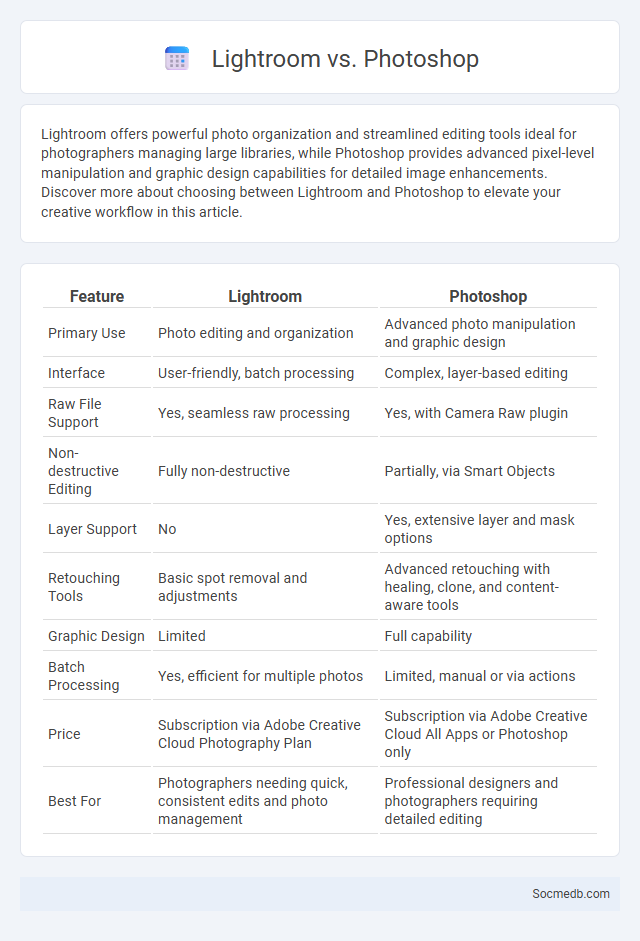
Photo illustration: Lightroom vs Photoshop
Lightroom offers powerful photo organization and streamlined editing tools ideal for photographers managing large libraries, while Photoshop provides advanced pixel-level manipulation and graphic design capabilities for detailed image enhancements. Discover more about choosing between Lightroom and Photoshop to elevate your creative workflow in this article.
Table of Comparison
| Feature | Lightroom | Photoshop |
|---|---|---|
| Primary Use | Photo editing and organization | Advanced photo manipulation and graphic design |
| Interface | User-friendly, batch processing | Complex, layer-based editing |
| Raw File Support | Yes, seamless raw processing | Yes, with Camera Raw plugin |
| Non-destructive Editing | Fully non-destructive | Partially, via Smart Objects |
| Layer Support | No | Yes, extensive layer and mask options |
| Retouching Tools | Basic spot removal and adjustments | Advanced retouching with healing, clone, and content-aware tools |
| Graphic Design | Limited | Full capability |
| Batch Processing | Yes, efficient for multiple photos | Limited, manual or via actions |
| Price | Subscription via Adobe Creative Cloud Photography Plan | Subscription via Adobe Creative Cloud All Apps or Photoshop only |
| Best For | Photographers needing quick, consistent edits and photo management | Professional designers and photographers requiring detailed editing |
Introduction to Lightroom, Photoshop, and the Description Box
Lightroom and Photoshop are essential tools for social media content creators, enhancing photos with professional editing features to improve visual appeal and engagement. Lightroom offers streamlined adjustments for light, color, and tone, while Photoshop provides advanced capabilities such as layering, masking, and retouching for detailed image manipulation. The description box on platforms like Instagram and YouTube plays a critical role in SEO by allowing creators to include keywords, hashtags, and calls to action that boost discoverability and audience interaction.
Key Features of Lightroom
Lightroom's key features include advanced photo editing tools such as exposure adjustment, color correction, and selective editing, enabling social media users to create visually stunning images. Its robust organizational capabilities like keyword tagging, metadata management, and cloud sync facilitate efficient content management across devices. Integration with social media platforms allows seamless sharing, enhancing engagement and audience reach.
Key Features of Photoshop
Photoshop offers advanced social media content creation tools, including precise image editing, customizable templates, and powerful layering capabilities that allow users to design eye-catching posts. Its extensive library of filters, effects, and retouching options enhances visual appeal while maintaining high resolution suitable for multiple platforms like Instagram, Facebook, and Twitter. Integration with Adobe Creative Cloud enables seamless collaboration and access to assets, streamlining the workflow for social media marketers and content creators.
The Role of the Description Box in Photo Editing
The description box plays a crucial role in photo editing on social media by providing context, enhancing engagement, and improving discoverability through keyword optimization. Detailed descriptions help convey the story behind the image, making posts more relatable and shareable across platforms like Instagram, Facebook, and TikTok. Effective use of hashtags and descriptive language within the box boosts search engine optimization (SEO), driving organic traffic and increasing visibility.
Lightroom vs Photoshop: Core Differences
Lightroom excels in managing and enhancing large batches of social media photos with non-destructive editing, offering streamlined tools for exposure, color correction, and organization that suit your fast-paced content creation. Photoshop provides advanced pixel-level manipulation, enabling detailed retouching, compositing, and complex graphic design tasks essential for creating unique visual content. Understanding these core differences helps you select the right tool for efficient photo editing and optimized social media visuals.
When to Use Lightroom Over Photoshop
Lightroom excels in efficient batch photo editing and organizing large image libraries, making it ideal for photographers managing numerous files. It provides powerful non-destructive adjustments optimized for color grading, exposure, and contrast, ensuring consistent edits across multiple photos. Photoshop is better suited for detailed, pixel-level retouching and complex compositions that require advanced layering and manipulation.
When to Use Photoshop Over Lightroom
Photoshop excels over Lightroom when detailed image manipulation, such as precise retouching, compositing, or layer-based editing, is required for social media content. Complex graphic designs, text overlays, and advanced masking techniques enhance visual storytelling and brand identity on platforms like Instagram and Facebook. Lightroom remains ideal for bulk photo editing and color correction, but Photoshop provides unmatched control for high-impact visuals.
Optimizing Metadata with the Description Box
Optimizing metadata within the description box enhances social media content discoverability by incorporating relevant keywords and hashtags. Clear and concise descriptions improve engagement rates and support search engine algorithms in accurately categorizing posts. Effective metadata optimization also boosts visibility across platforms like Instagram, YouTube, and Facebook, driving targeted traffic and audience growth.
Workflow Integration: Lightroom, Photoshop, and Metadata
Seamless workflow integration between Lightroom and Photoshop enhances social media content creation by enabling efficient photo editing and retouching while preserving high-resolution quality. Embedding comprehensive metadata such as keywords, captions, and copyright information streamlines asset management and improves searchability across platforms like Instagram and Facebook. This integrated approach accelerates publishing schedules and ensures consistent branding for social media campaigns.
Conclusion: Choosing the Right Tool for Your Needs
Selecting the right social media platform depends on your specific goals, audience demographics, and content style to maximize engagement and ROI. Tools like Instagram excel in visual storytelling, while LinkedIn is ideal for B2B networking and professional growth. Evaluating analytics and user behavior on these platforms ensures a strategic approach that aligns with your marketing objectives.
 socmedb.com
socmedb.com